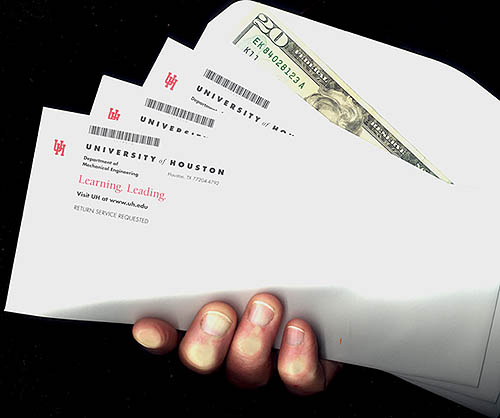The Envelope Game
by Andrew Boyd
Today, guest scientist Andrew Boyd defies common sense. The University of Houston presents this series about the machines that make our civilization run, and the people whose ingenuity created them.
Let's play a game. In my hand I hold a hundred envelopes. Each contains some amount of money -- maybe a dollar, maybe ten, maybe a million. All you know is that each envelope contains something. This holiday season, I'm going to let you choose one of the envelopes as a present. But you have to make your decision in a very special way:
First, pick any envelope and look inside. If you like the amount, you can keep it. If you don't, you can pick another envelope. We'll keep doing this until you find the envelope you want. The only rule, and this is what makes the game interesting, is that once you say "No" to an envelope, you can't go back.
How hard is it to find the envelope with the most money? If you could pick only one of the hundred envelopes at random, your chances of finding the envelope with the most money would be one percent. But can you use information from the envelopes you open to improve your chances?
One strategy you might use works as follows: Pick some number of envelopes, say, ten, and open them. Reject all of them, but record the largest amount of money you see. Maybe, in the first ten envelopes, the most money in any one is fifty dollars. Now go through the remaining ninety envelopes and stop when you come to the first one that has more than fifty dollars. Of course, if you don't find one with more than fifty, then you have to resign yourself to keeping the last envelope, whatever's in it.
If you do this, what do you think your chances of getting the envelope with the most money would be? Still one in a hundred? Better? Worse?
It turns out that your best bet is to use this strategy, but going through just over a third of the envelopes, not ten. Then your chance of finding the envelope with the most money is also about a third. For every three times you play, you'll generally take home the fattest envelope once.
Even more amazing: the odds never drop below one third, no matter how many envelopes we start with. If we had a million envelopes or a billion, rejecting a little more than a third does the job. In fact, for a very large number of envelopes, the mathematical odds are exactly 36.78... percent.
Having worked with numbers most of my life, I never cease to be amazed at how often they defy common sense. Yet, with every passing year, I more fully appreciate what the logical part of my brain has always known. The numbers aren't defying anything; it's our common sense that wants to defy the world around us.
We smile and shrug at these surprises. But if common sense can't tell us what to do with the Envelope Problem, how can we hope that it will guide us in more complex matters - global warming, the threat of terrorism, or the cure for cancer?
We make it through the day by relying on common sense. It keeps our car on the right side of the road, and us out of trouble at work. But now and then, rivers of interconnection run beneath the surface. It's then that we have to take a hard look at the facts and ask, does common sense really make sense?
I'm Andy Boyd at the University of Houston, where we're interested in the way inventive minds work.
Dr. Andrew Boyd is Chief Scientist and Senior Vice President at PROS, a provider of provider of pricing and revenue optimization solutions. Dr. Boyd received his A.B. with Honors at Oberlin College with majors in Mathematics and Economics in 1981, and his Ph.D. in Operations Research from MIT in 1987. Prior to joining PROS, he enjoyed a successful ten-year career as a university professor.
The envelope game is more commonly known in mathematical circles as the secretary problem, deriving from a scenario in which a manager is interviewing candidates for an administrative position rather than choosing an envelope. The mathematical analysis of the problem may be found on line.
The precise result for the number of envelopes one would best look at out of a very large number of envelopes, N, would be N/e, where e is the base for natural logarithms, 2.718... . That would be 37.68... percent of N.
